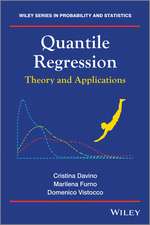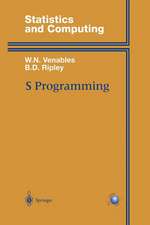Mathematical and Statistical Modeling for Emerging and Re-emerging Infectious Diseases
Editat de Gerardo Chowell, James M. Hymanen Limba Engleză Hardback – 9 aug 2016
- Can we control Ebola via ring vaccination strategies?
- How quickly should we detect Ebola cases to ensure epidemic control?
- What is the likelihood that an Ebola epidemic in West Africa leads to secondary outbreaks in other parts of the world?
- When does it matter to incorporate the role of disease-induced mortality on epidemic models?
- What is the role of behavior changes on Ebola dynamics?
- How can we better understand the control of cholera or Ebola using optimal control theory?
- How should a population be structured in order to mimic the transmission dynamics of diseases such as chlamydia, Ebola, or cholera?
- How can weobjectively determine the end of an epidemic?
- How can we use metapopulation models to understand the role of movement restrictions and migration patterns on the spread of infectious diseases?
- How can we capture the impact of household transmission using compartmental epidemic models?
- How could behavior-dependent vaccination affect the dynamical outcomes of epidemic models?
| Toate formatele și edițiile | Preț | Express |
|---|---|---|
| Paperback (1) | 565.94 lei 38-44 zile | |
| Springer International Publishing – 12 iun 2018 | 565.94 lei 38-44 zile | |
| Hardback (1) | 586.17 lei 38-44 zile | |
| Springer International Publishing – 9 aug 2016 | 586.17 lei 38-44 zile |
Preț: 586.17 lei
Preț vechi: 732.71 lei
-20% Nou
Puncte Express: 879
Preț estimativ în valută:
112.16€ • 117.42$ • 92.81£
112.16€ • 117.42$ • 92.81£
Carte tipărită la comandă
Livrare economică 01-07 aprilie
Preluare comenzi: 021 569.72.76
Specificații
ISBN-13: 9783319404110
ISBN-10: 3319404113
Pagini: 385
Ilustrații: IX, 356 p. 94 illus., 63 illus. in color.
Dimensiuni: 155 x 235 x 24 mm
Greutate: 0.83 kg
Ediția:1st ed. 2016
Editura: Springer International Publishing
Colecția Springer
Locul publicării:Cham, Switzerland
ISBN-10: 3319404113
Pagini: 385
Ilustrații: IX, 356 p. 94 illus., 63 illus. in color.
Dimensiuni: 155 x 235 x 24 mm
Greutate: 0.83 kg
Ediția:1st ed. 2016
Editura: Springer International Publishing
Colecția Springer
Locul publicării:Cham, Switzerland
Cuprins
Preface.- A Reality of Its Own.- Modeling the Impact of Behavior Change on the Spread of Ebola .- A model for coupled outbreaks contained by behavior change.- Real-time assessment of the international spreading risk associated with the 2014 West African Ebola Outbreak.- Modeling the case of early detection of Ebola virus disease.- Modeling ring vaccination strategies to control Ebola virus disease epidemics.- Estimation of the number of sickbeds during Ebola epidemics using optimal control theory.- Inverse problems and Ebola virus disease using an age of infection model.- Assessing the Efficiency of Movement.- Restriction as a Control Strategy of Ebola.- Patch models of EVD transmission dynamics.- From bee species aggregation to models of disease avoidance: The \emph{Ben-Hur} effect}.- Designing Public Health Policies to Mitigate the Adverse Consequences of Rural-Urban Migration via Meta-Population Modeling.- Age of Infection Epidemic Models.- Optimal Control of Vaccination in an Age-Structured Cholera Model.- A Multi-risk Model for Understanding the Spread of Chlamydia.- The 1997 Measles Outbreak in Metropolitan São Paulo, Brazil: Strategic Implications of Increasing Urbanization.- Methods to determine the end of an infectious disease epidemic: A short review.- Statistical considerations in infectious disease randomized controlled trials.- Epidemic models with and without mortality: when does it matter?- Capturing Household Transmission in Compartmental Models of Infectious Disease.- Bistable endemic states in a Susceptible-Infectious-Susceptible model with behavior-dependent Vaccination.- Index.
Recenzii
“This book focuses on mathematical and statistical modeling to capture the important aspects of emerging epidemics that can help public health workers and researchers to better understand the spread of infections and reduce the uncertainty of the estimates of disease prevalence, as well as to help evaluate the potential effectiveness of different approaches for bringing an epidemic under control. … recommended to researchers in the field of mathematical epidemiology and public health workers who are involved in epidemic disease control.” (Hemang B. Panchal, Doody's Book Reviews, November, 2016)
Notă biografică
Gerardo Chowell is an associate professor and a Second Century Initiative Scholar (2CI) in the School of Public Health at Georgia State University in Atlanta. His research program includes the development and application of quantitative approaches for understanding the transmission dynamics and control of infectious diseases including influenza, Ebola, and dengue fever. His work has appeared in high-impact journals including The New England Journal of Medicine, PLOS Medicine, and BMC Medicine, and has been cited by major media outlets including the Washington Post and TIME magazine.
James (Mac) Hyman has developed and analyzed mathematical models for the transmission of HIV/AIDs, influenza, malaria, dengue fever, chikungunya, and infections. His current focus is to identify approaches where these models can help public health workers be more effective in mitigating the impact of emerging diseases. He was aresearch scientist at Los Alamos National Laboratory for over thirty years, is a past president of the Society for Industrial and Applied Mathematics (SIAM), and now holds the Phillips Distinguished Chair in Mathematics at Tulane University.
James (Mac) Hyman has developed and analyzed mathematical models for the transmission of HIV/AIDs, influenza, malaria, dengue fever, chikungunya, and infections. His current focus is to identify approaches where these models can help public health workers be more effective in mitigating the impact of emerging diseases. He was aresearch scientist at Los Alamos National Laboratory for over thirty years, is a past president of the Society for Industrial and Applied Mathematics (SIAM), and now holds the Phillips Distinguished Chair in Mathematics at Tulane University.
Textul de pe ultima copertă
The contributions by epidemic modeling experts describe how mathematical models and statistical forecasting are created to capture the most important aspects of an emerging epidemic.Readers will discover a broad range of approaches to address questions, such as
- Can we control Ebola via ring vaccination strategies?
- How quickly should we detect Ebola cases to ensure epidemic control?
- What is the likelihood that an Ebola epidemic in West Africa leads to secondary outbreaks in other parts of the world?
- When does it matter to incorporate the role of disease-induced mortality on epidemic models?
- What is the role of behavior changes on Ebola dynamics?
- How can we better understand the control of cholera or Ebola using optimal control theory?
- How should a population be structured in order to mimic the transmission dynamics of diseases such as chlamydia, Ebola, or cholera?
- How can we objectively determine the end of an epidemic?
- How can we use metapopulation models to understand the role of movement restrictions and migration patterns on the spread of infectious diseases?
- How can we capture the impact of household transmission using compartmental epidemic models?
- How could behavior-dependent vaccination affect the dynamical outcomes of epidemic models?
Caracteristici
Provides contributions by epidemic modeling experts describing a broad range of approaches to address contemporary questions related to the spread and control of infectious diseases Demonstrates examples of how models can help understand the spread of infections Presents a discussion on the modern statistical modeling methods to design, conduct, and analyze clinical trials measuring the effectiveness of potential vaccines Includes supplementary material: sn.pub/extras










